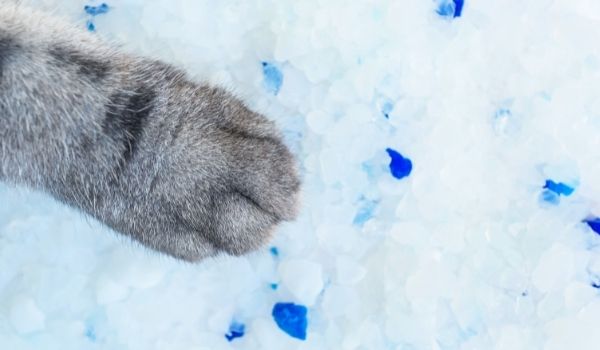Cats are curious creatures and are often seeking out things they shouldn’t have. At times, their eagerness may get them into trouble. You may find your cat toying or exploring your new shoebox, your purse, or just a suitcase lying around. The danger that lies here is that these packages may contain silica gel, and your furry friend may end up ingesting it.
Silica gel is known to cause choking or gastrointestinal upset. Here, we discuss everything about silica gel and what to do if your cat eats silica gel.
What is Silica Gel?

Silica gel is a desiccant or drying agent used in packaging to avoid damage from moisture. They are small, round, transparent beads formed from silicon dioxide. These packets can be found in bottles of medications, purses, bags, shoes or shoe products, coats, and jacket pockets as a preservative. It usually comes in white pouches with the label “DO NOT EAT.”
Crystallized cat litter also contains silica gel. This proves to be a good litter as it helps absorb moisture and odor. It is safe to use, and a titbit bite is unlikely to harm your nosy cat!
White silica gel is usually non-toxic. Although it is an irritant and if consumed in large quantities, it may cause choking or intestinal obstruction.
Furthermore, dyed silica gel, such as blue and green silica gel, contains harmful chemicals like cobalt chloride and methyl violet coatings, respectively. These are toxic carcinogens that can cause inhalational and allergic reactions. Also, it may affect different organs and systems of your pet, such as the liver, kidneys, lungs, eyes, thyroid, and blood. Colored silica is also an eye and respiratory tract irritant and may sensitize the skin. Be sure to inform the vet what kind of silica gel your cat has consumed because of its potential carcinogenic properties.
What to Do if Your Cat Eats Silica Gel?
If you do find out that your cat has consumed silica gel, firstly, do not panic. Notice your cat for any peculiar or odd behavior. Look for the packet and see if she has consumed a whole sachet or just a portion. If the whole sachet is missing or if you’re unsure that your cat might have eaten more than one, contact your vet for further advice.
However, if your cat seems well and you find the packet with a few nibbles and bites, fret not. Due to the gel’s moisture absorbing property, it may irritate and extract fluid from cats’ gut, causing them to vomit or have a few loose poos. This isn’t much to stress about, and it is highly probable that the silica gel pouch or beads may pass out in your cat’s stool.
Nonetheless, if your cat seems particularly unwell, it will be wise to visit your vet’s clinic immediately for a detailed evaluation.
Risks Associated With Ingestion of Silica Gel
If you suspect that your cat has consumed silica gel, watch for some signs. Some signs and symptoms that a feline has been seriously harmed by ingesting silica gel are:
- Loss of appetite
- Vomiting
- Unable to pass stool or constipation
- Diarrhea
- Irritation and lethargy
- Abdominal distention
- Refusing to eat or lie down
- Fever
- Difficulty in breathing
- Dry mouth and eyes
- Thick saliva
- Dry and cracked tongue
- Halitosis
Although silica gel itself is not toxic, it may cause intestinal obstruction. This signifies that a blockage is present in your pet’s gut, which prevents fluids and nutrients from being absorbed in the tract. Also, the stool is unable to make its way through the intestinal tract. This makes cats lethargic, dehydrated, and irritable with a distended abdomen. This can be serious and life-threatening.
Another risk ingesting silica gel poses is a choking hazard. The gel may plunge into the cat’s trachea (windpipe) rather than its esophagus (food pipe). If you see that your furry friend is panicking and unable to breathe, rush to the veterinarian urgently.
Signs that a cat is choking are:
- Retching and gagging
- Difficult or labored breathing
- Excessive salivation/drooling
- Pawing at her mouth
- Panicked look on her face
- Chest with no airway sounds
Things Not to Do if a Cat Has Eaten Silica Gel?
Once you’re sure of the fact that your inquisitive feline friend has consumed silica gel, the foremost thing not to do is panic. Secondly, it is not a great idea to try and induce vomiting in your cat. Silica gel may cause more risks on the way back up than it will by remaining in the gut. This should be only done by a professional and in a clinic—if they think it’s absolutely necessary.
Do not over hydrate or force your cat to eat, as this may cause more abdominal distention along with constipation, increasing the size of the obstruction. Let your vet decide how to treat your cat and be patient.
Taking your cat to a vet will be a wise idea after you find out it has ingested silica gel. If your cat is behaving normally but has a mild tummy upset associated with vomiting, your vet will treat her with some intravenous fluids for hydration.
However, if your vet is worried about an obstruction, they may run some tests after examining your cat for further evaluation. These can include X-rays and CT scans to locate the site of obstruction. Once the site is confirmed, your vet might suggest surgery under general anesthesia. The risks and complications of the surgery can only be identified by the operating vet and depend on the location and duration of the obstruction.
Cats and Silica Gel: Conclusion
The lesson learned here is that silica gel is chemically and biologically inert and non-toxic if swallowed. Yet, if ingested in large quantities, it can cause choking or obstruction. Therefore, it is well-advised to keep packages and products containing silica gel out of reach from your pets.
